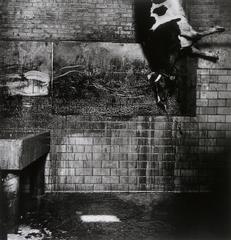
| 8 of 11 |

|
In order for Liebling to document work in a slaughterhouse he had to actually go there, a trip few of us would relish taking. In photographs like these there is the power of an additional message: “I can show you this because I was there.” The document becomes one of both the slaughterhouse and Liebling’s personal experience. “For Liebling, as for every major figure in photography, pictorial power arises from the desire to be with the world, not merely to record but to register the fact of one’s own presence, to project one’s self in the act of capturing a scene.” (Alan Trachtenberg, Jerome Liebling Photographs, 1982) |
There is an odd beauty in this photograph of a slaughterhouse wall. The abstract shapes of all the rectangles are like a collage and the shimmering texture of the walls are painterly, like brushstrokes in a painting. At first it isn’t even clear what the cow is doing here, dangling at that strange angle. Or is it that the picture is not right-side up?
When Jerome Liebling went to slaughterhouses in South St. Paul, Minnesota, to ask permission to photograph the work there, he wasn’t interested in exposing the horror of a slaughterhouse or promoting a vegetarian lifestyle. In fact he wanted to document what very few meat consumers would ever see–the reality of preparing meat for human consumption. In documenting the process, he created a photograph that expresses the conflicting emotions that many feel over the way meat is processed.
“My photographs deal primarily with what I considered the most heroic moments in the process: the slaughter, the symbolic relationship between workers and animals,” wrote Liebling. “For the men on the killing floor, there was always great danger balanced by their skill and stoicism… men’s hands trained to function like machines performed the one act in the process that could not be mechanized.” (The Minnesota Photographs, 1997)
| 8 of 11 |